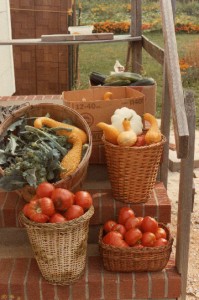I completed my first masonry project! All right – I started it. I actually worked with concrete. This may seem like a no-big-deal kind of thing, but for someone like me, it’s a big deal. As a child, my father wouldn’t teach me about tools, home improvements, how to fix things. I’m not sure he really knew how to do these things, so he may have doubted his own abilities to teach me how to do them. Still and all, my husband often gets frustrated when he asks me to hand him a tool while he’s working on a project and I’m fumbling around on the workbench for something that seems obvious to him.
John’s a great teacher. He mixed the cement, and used metaphors to help me understand in my own way how to do the same thing. For example, as he mixed the cement in the wheel barrow, he said, “Add water and stir it until it looks like chocolate cake batter.” Got it! I know what the consistency of cake batter should look like. As we connected the edging stones we’d picked up from around the property to frame the front garden, he handed me the trowel (hod? What is the tool with the pointy end you use to spread cement?). “Spread it like frosting.” Got it!
The result is about ten feet completed of the edging around our front landscaping. We finished laying the landscape frabric, spread the mulch, and selected the stones for the edging. All the stones are from our property. The sparkling quartz, with pink and white veins running through it, catches the sunlight.
I purchased the remaining edging blocks for the front sidewalk and stumbled on some great plant bargains at Lowe’s. I purchased two already planted mixed containers for fifty cents each. Huge, overflowing with petunias, bacopa and what looks like some sort of allysum, the matched set perked up my front steps perfect. I began pricing the lumber for the raised vegetables beds too. The Master Gardener at the Kentucky State University Arboretum recommended the plastic wood, the type used to make permanent decks, but the cost was astonishing. $25 to $30 for each 12 foot section. We hope to make nine raised beds total and fence in the area with board and post fence covered by chicken wire to keep out the critters. If I use that stuff I will be spending hundreds of dollars. Instead, I’ll opt for the pressure treated lumber at $4 a board. I know that the pressure treatedl umber is controversial, since some critics content it leaches chemicals into the soil. But I just can’t afford the PVC option.
We mapped out the area for the shed and I reiterated my desire to have my chickens in by next spring. A small hen house for three to six hens is sufficient, fences in against predators.
But if I get my vegetable beds in place I’ll be a happy woman. I’m really disappointed with the produce selection down here in the country. I don’t know if it’s the growing season or what, but we found better produce back in New York at the supermarket. Everything is very expensive and not the best quality. Even the Amish farmstand this weekend had a poor selection. I managed to pick up a cantalope that’s delicious, some squash and a tomato, but everything else either looked bad or was commercially grown (I checked with the lady running the stand; she pointed out to me what was local and what wasn’t.)
So the solution for me is to grow my own vegetables. I hope to document the process for my eHow articles as well as the new gardening book I’m writing.
This morning the flock of 20 turkeys came out of the woods and made the rounds around the house, pecking up all the bugs. They traversed the back field, made their way through the fruit orchard, and ended the show by marching in a line down my driveway and into the perennial garden. I prayed that they would eat every Japanese Beetle they could find in the perennial garden, but after some half-hearted pecks, they departed into the woods. One flew up and perched in the pine tree. I hadn’t realized they could fly that well!
Enjoy your day and let me know how you like the blog! The photo was taken by my sister, Mary Fassetta.





